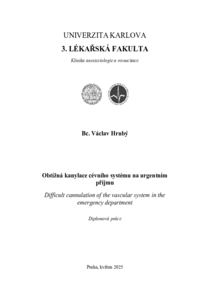Obtížná kanylace cévního systému na urgentním příjmu
Difficult cannulation of the vascular system in the emergency department
diploma thesis (DEFENDED)

View/
Permanent link
http://hdl.handle.net/20.500.11956/200124Identifiers
Study Information System: 277639
Collections
- Kvalifikační práce [3251]
Author
Advisor
Referee
Kubalová, Jana
Faculty / Institute
Third Faculty of Medicine
Discipline
Intensive Care
Department
Department of Nursing 3FM CU
Date of defense
16. 6. 2025
Publisher
Univerzita Karlova, 3. lékařská fakultaLanguage
Czech
Grade
Excellent
Obtížná kanylace cévního systému se stává čím dál častějším problémem, se kterým se zdravotníci v klinické praxi setkávají, zejména pak na exponovaných pracovištích jako je urgentní příjem. Je tedy nezbytné na tuto problematiku adekvátně reagovat. Hlavním cílem práce tedy bylo na základě propojení teoretického podkladu a získaných dat připravit návrh programu vzdělávacího kurzu, který se bude komplexně zabývat obtížnou kanylací cévního systému, včetně alternativních metod zajištění cévního vstupu. Výzkumná část práce kombinovala dotazníkové šetření mezi nelékařským zdravotnickým personálem a praktický sběr dat prostřednictvím checklistů u reálných pacientů. Dotazníkového šetření se celkem zúčastnilo 58 respondentů a bylo vyplněno 57 checklistů. Výsledky ukázaly, že délka praxe nemá vliv na výskyt obtížné kanylace, přičemž mezi respondenty dominovaly metody opakované kanylace periferní žíly a změna zdravotníka. Dále byly stanoveny potencionální rizikové faktory, které mohou přispívat k obtížné kanylace cévního systému. Významným zjištěním bylo také to, že predikce obtížné kanylace samotným pacientem může být spolehlivým ukazatelem, a že adekvátní reakce zdravotníků na tuto predikci vede ke snížení celkového počtu pokusů o kanylaci. Z dotazníkového šetření rovněž vyplynulo nízké proškolení pracovníků...
Difficult cannulation of the vascular system is becoming an increasingly common problem encountered by healthcare professionals in clinical practice, particularly in exposed workplaces such as the emergency department. It is therefore essential to respond adequately to this issue. The main ambition of this thesis was to establish a correlation between the theoretical framework and the empirical data collected to prepare a proposal for an educational course that will comprehensively address difficult cannulation of the vascular system, including alternative methods of securing vascular access. The research part of the work combines a survey among non-medical health care staff and practical data collection through checklists with real patients. A total of 58 respondents participated in the survey out of which 57 checklists were completed. The results showed that the length of practice has no impact on the incidence of difficult cannulation, with repeated peripheral vein cannulation and changing the healthcare professional being the most commonly used methods among the respondents. Potential risk factors that may contribute to difficult vascular cannulation were also identified. Another important finding is that the prediction of difficult cannulation by the patient themselves can be a reliable...
